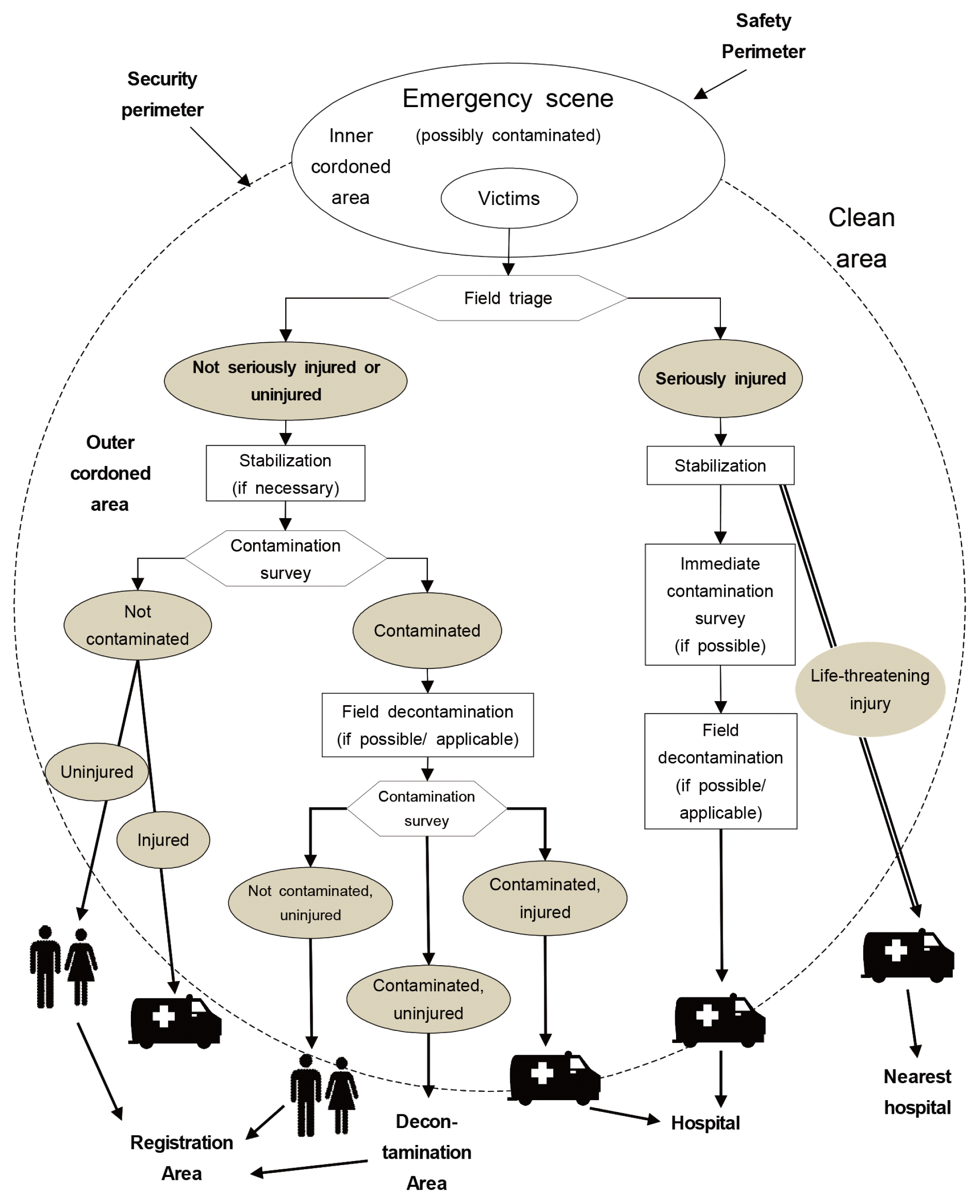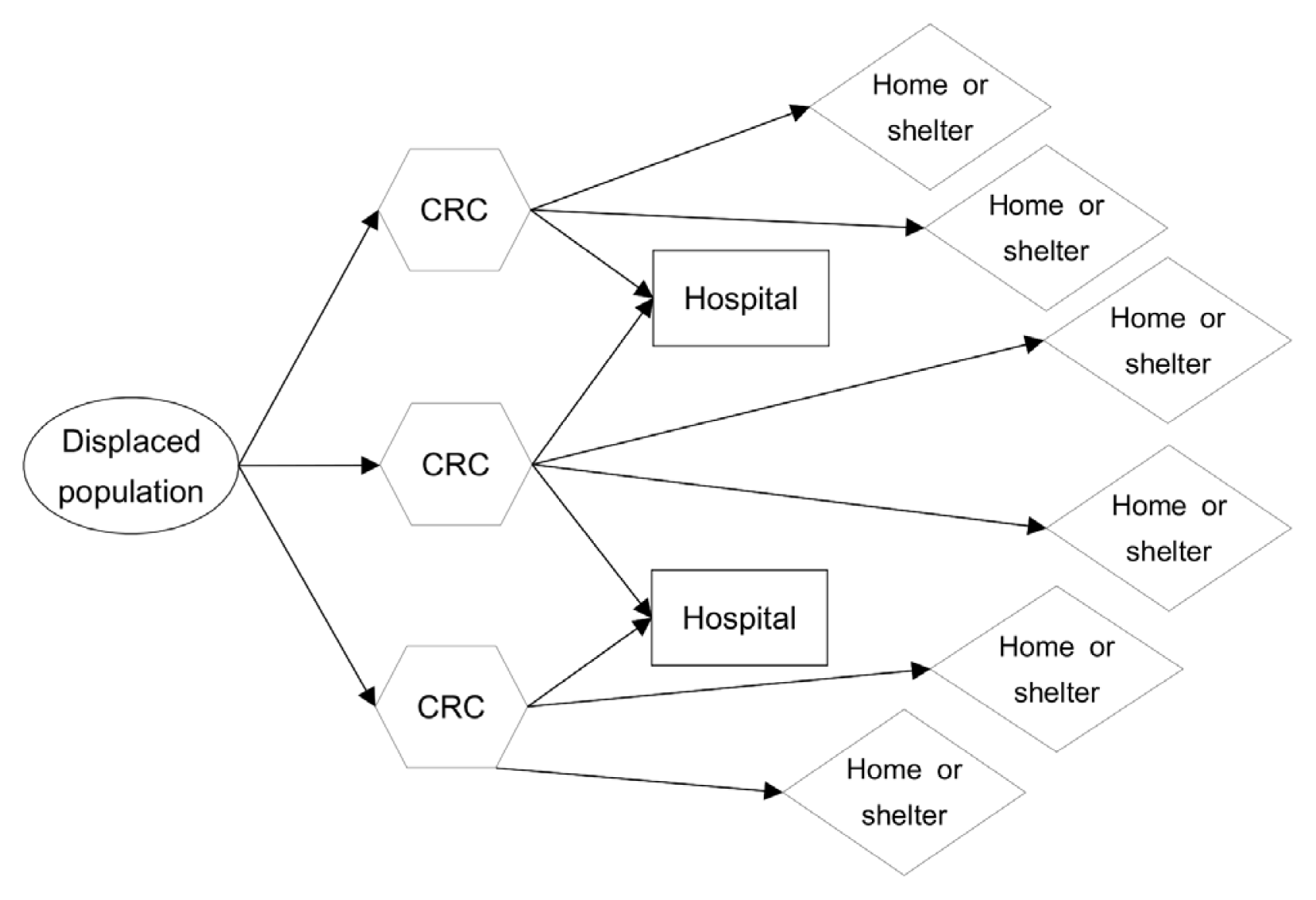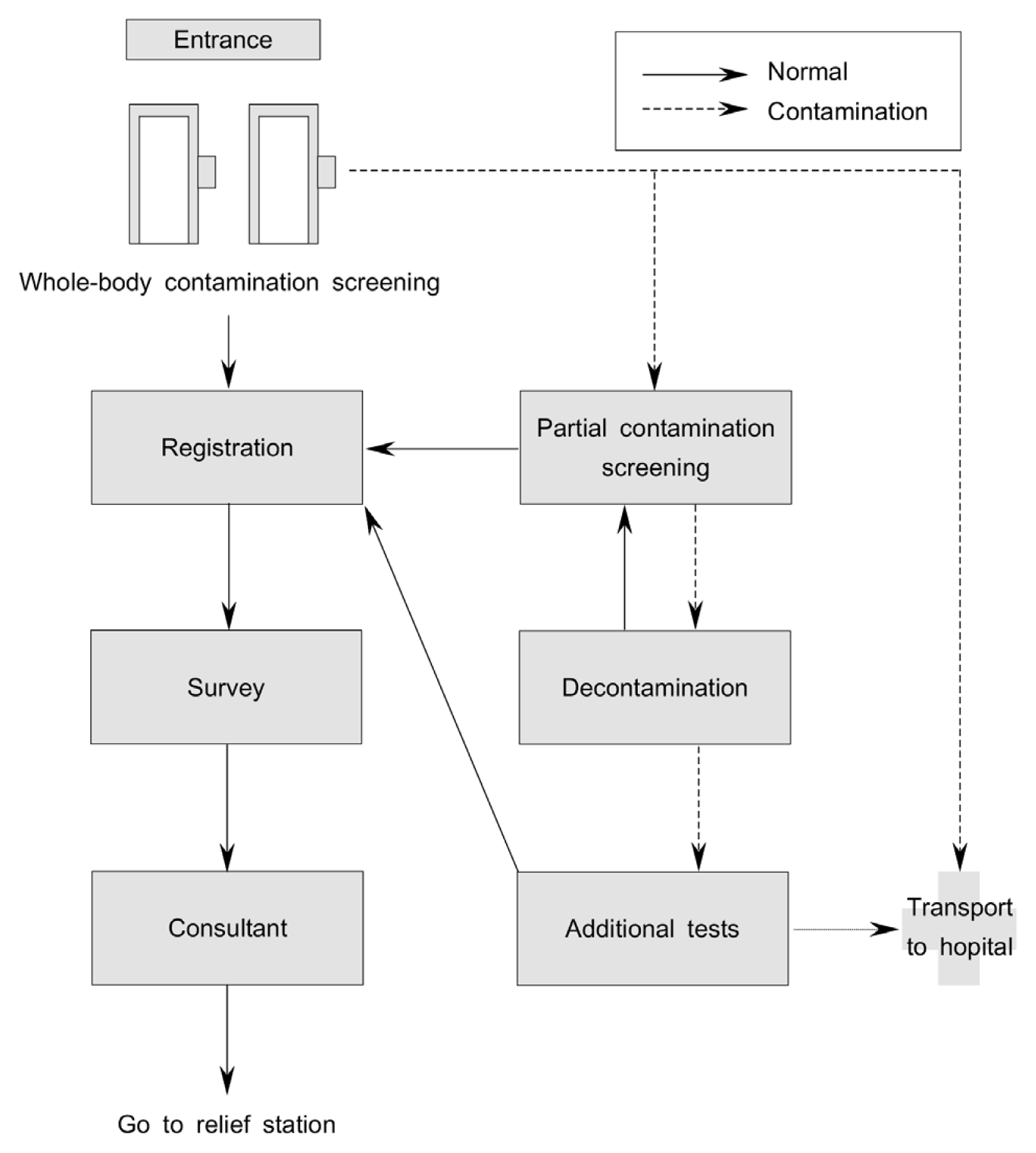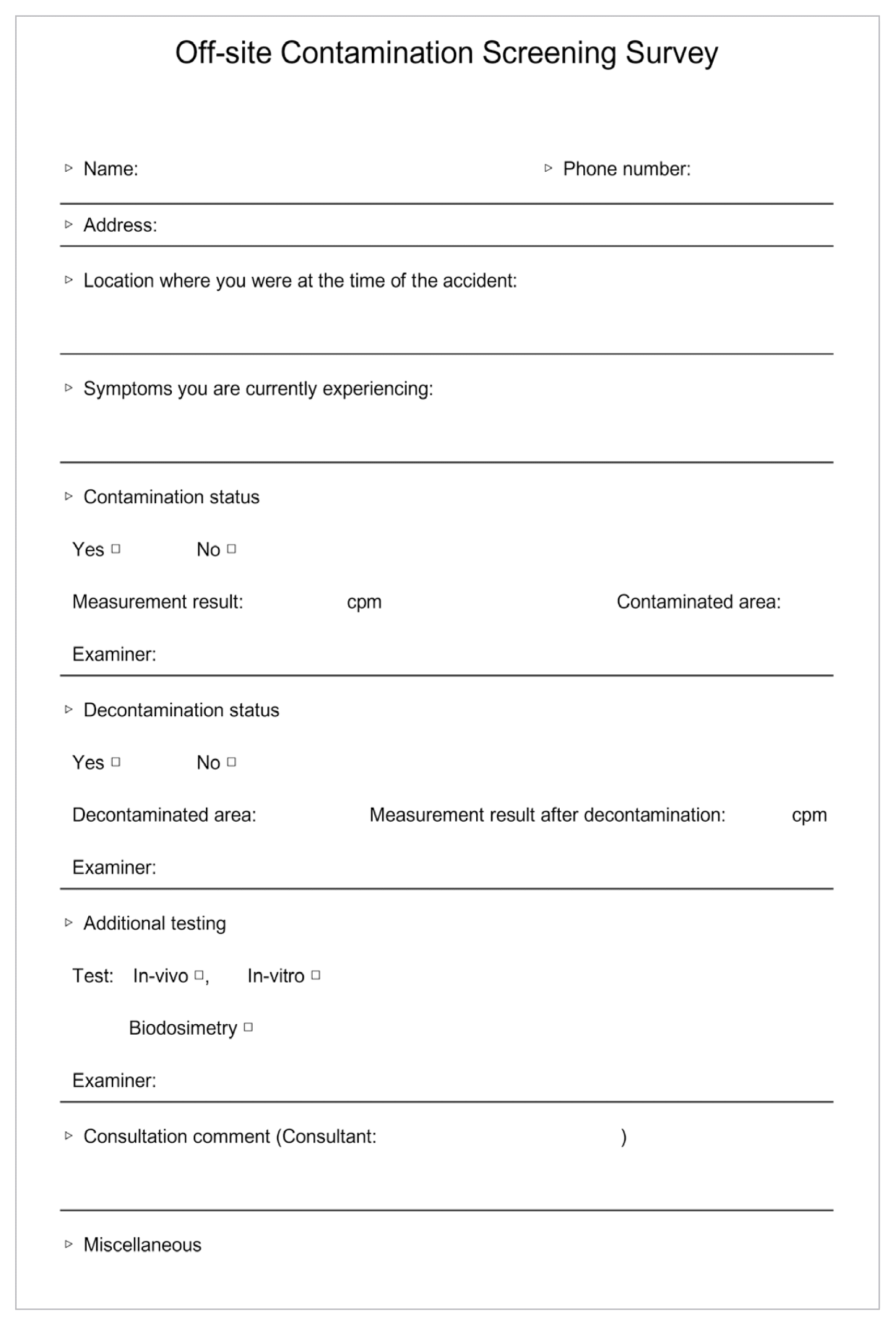An Off-site Screening Process for the Public in Radiation Emergencies and Disasters
Article information
Abstract
Background
A contamination screening process for the local population in radiation emergencies is discussed.
Materials and Methods
We present an overview of the relevant Korean governmental regulations that underpin the development of an effective response system. Moreover, case studies of foreign countries responding to mass casualties are presented, and indicate that responses should be able to handle a large demand for contamination screening of the local public as well as screening of the immediate victims of the incident.
Results and Discussion
We propose operating procedures for an off-site contamination screening post operated by the local government for members of the public who have not been directly harmed in the accident. In order to devise screening categories, sorting strategies assessing contamination and exposure are discussed, as well as a psychological response system.
Conclusion
This study will lead to the effective operation of contamination screening clinics if an accident occurs. Furthermore, the role of contamination screening clinics in the overall context of the radiation emergency treatment system should be clearly established.
Introduction
After the occurrence of a large-scale radiation emergency or disaster, the Korean government operates a government-driven radiation emergency response system for emergency alerts higher than code-blue emergencies. The Nuclear Safety and Security Commission (NSSC) is responsible for operating the central radiation disaster prevention and response headquarters (“Central Headquarters”) and ensuring that specialized organizations designated for each area respond, according to the Act on Measures for the Protection of Nuclear Facilities, etc. and Prevention of Radiation Disasters. In particular, the National Radiation Emergency Medical Center (NREMC) of the Korea Institute of Radiological and Medical Sciences (KIRAMS) provides medical treatment for irradiated victims. Moreover, to ensure prompt responses, regional radiation emergency medical centers are to be implemented.1)
The main role of the NREMC is to provide medical treatment for the immediate victims of the accident, such as the provision of consultation and technical support regarding medical relief in radiation emergencies and disasters and the collection of materials to evaluate the radiation exposure dose [1]. The Korea Institute of Nuclear Safety (KINS) has the mission of establishing and operating the technical support headquarters for radiation protection, while nuclear plant operators are responsible for establishing and operating emergency headquarters in case of nuclear plant accidents. The law states that the local radiation safety response centers in the emergency planning zones of each city and province are to be controlled by the respective local governments in order to facilitate prompt gathering and evacuation of the residents. To that end, peacetime relief stations are to be designated and maintained.
However, due to the unique nature of radiation emergencies and disasters, radiation contamination may occur in areas neighboring the accident site in a short period of time. Moreover, the public may exhibit a heightened fear of radiation. Thus, proper contamination screening and protective measures are essential for more than the immediate victims. To that end, the NREMC is in charge of providing contamination screening and treatment not only for immediate victims of the accident (the injured), but also inhabitants (possible casualties) of the region affected by the accident. In addition, the NREMC runs off-site radiation emergency clinics near the accident site [2].
However, the main object of treatment in the initial stage of the accident remains immediate victims and off-site responders. Moreover, in order to ensure the prompt transport of victims, the center should be located close to the accident site. Therefore, it may not be reasonable to have the center provide contamination screening for local inhabitants at the same time. Furthermore, despite being at some distance from the accident site, if the fear of radiation intensifies in the public, the need to provide contamination screening effectively for those who live farther from the accident site should be also considered. Therefore, the roles of the center should be functionally divided.
This study discusses contamination screening steps for local inhabitants in case of a large-scale radiation emergency or disaster. To that end, we reviewed the current system of radiation-protective measures in Korea as well as instances of radiation emergencies and disasters that have occurred outside the country, with a focus on the characteristics of the cases and the responses of the respective countries. Moreover, we review the functions of off-site contamination screening in the U.S., with the aim of establishing a system for off-site contamination screening clinics that fits circumstances in Korea. Finally, we discuss how contamination screening should be evaluated in order to establish effective processes.
The Current Radiation Disaster Prevention Response System
1. Relevant law and roles of local governments
According to the Act on Measures for the Protection of Nuclear Facilities, etc. and Prevention of Radiation Disasters, if a radiation accident resulting in a radiological emergency occurs, a radiation disaster prevention response body should be promptly mobilized. In particular, if an accident occurs in large-scale nuclear facilities, such as nuclear power plants, organized government-level responses should be planned and regular education and training should be offered to maintain a response capability sufficient for actual accidents.
At the time of the occurrence of the accident, the Central Headquarters, whose head is the head of the NSSC, is to be launched. The roles of expert organizations in different areas in the local command system in emergency are stipulated in the law, and the regional radioactive disaster prevention and response headquarters are to be established and operated by local government. These centers are to play a crucial role in protecting the inhabitants of the affected areas. Moreover, the centers must plan the evacuation of many residents from the area as speedily as possible.
In particular, the off-site command centers for the prevention of radioactive disasters (“off-site command centers”) are to take urgent measures for the protection of residents, such as evacuation, implementing restrictions on food intake, and distributing thyroid-protective agents. In carrying out protective measures for individual residents, the centers use concrete criteria for acceptable environmental radiation doses and space doses (Figure 1).
In case of an emergency, the respective local governments where nuclear power plants are located should announce preparedness guidelines to gather inhabitants to the designated place and evacuate them to the designated relief stations via planned transport vehicles. Nevertheless, in general, local governments formulate plans only for the designation and operation of assembly places for evacuation and relief stations: No specific standards exist for contamination screening for ordinary residents, beyond the immediate victims of an accident or those who may have suffered serious internal or external contamination [2].
2. Radiation emergency medical support headquarters
The KIRAMS of the NREMC has a radiation emergency medical response system for providing medical care for radiation victims or possible casualties in case of an emergency. It is stipulated that if an accident occurs, the head of the KIRAMS should organize a medical support team to be dispatched to the site with the cooperation of primary and secondary radiation emergency medical institutions in nearby regions and promptly operate off-site clinics.
The treatment system of the off-site clinics is classified into a triage team, a decontamination team, a treatment team, and a transport team. The triage team divides victims depending on whether they have sustained medical injuries or radiological injuries. The victims categorized into the latter group are then graded from 1 to 3: victims with an injury level of 2 or 3, who do not exhibit signs or symptoms of exposure and contamination with radiation or radioactive materials, are considered to require long-term follow-up observation.
Based on these criteria, many residents who have not suffered direct injuries from the accident may fall into this category. A primer on radiation emergency treatment states that lower-priority casualties also warrant contamination measurements and recordings thereof, as well as long-term follow-up observation [1, 3].
However, the most crucial function of the off-site clinic is to provide radiological medical treatment for victims and possible casualties transported from the accident site, which is facilitated by being located as close to the safety perimeter within the security perimeter as possible. Therefore, it is important to establish the clinics in a timely manner in order to offer prompt treatment to victims who have suffered an injury or who are highly likely to have been injured. This suggests that the evaluation of the residents of neighboring areas for contamination is not the primary duty of these clinics (Figure 2).
3. Case studies of responses in other countries
After a nuclear power plant disaster occurred, Fukushima Prefecture in Japan, conducted emergency radiation exposure testing for screening the residents neighboring the nuclear plant for contamination. Simple external contamination tests were provided at some community health centers and gymnasiums for nearly a year from March 13, 2011, starting from two days after the occurrence of the accident [4].2) From March 13, when the emergency radiation exposure testing was initiated, 114,488 people were tested over the course of 18 days, of whom 102 were determined to have been contaminated based on the criterion for total decontamination (100,000 cpm) set by the Japanese government at the time.
Later, over the course of approximately a year, a total of 243,992 people received testing. Additionally, Fukushima Prefecture conducted thyroid testing for children beginning on March 24, 2011, as well as whole-body counting to measure 137Cs and 134Cs in the body. Judging from the irregularity in the test periods and the number of tests performed, we conjecture that the testing was done sporadically according to public sentiment, due to the unique nature of the disaster in the country at the time.
A similar case occurred in Goiania, Brazil, where 112,000 residents, nearly 10% of the whole population of the city, were screened for contamination in a large stadium, which led to extreme social chaos [5]. Such cases in different countries show that the ripple effects from radiation contamination and exposure can be explosive, due to the characteristics of large-scale radiation disasters. Moreover, regarding public protective measures, neighboring residents’ concerns about the accident emphasize the importance of having sufficient capacity for contamination screening of a large number of people.
Off-Site Contamination Screening System For Residents
1. Operations in other countries
The Centers for Disease Control and Prevention (CDC) in the U.S. have established a systematic process for contamination and exposure screening of residents in case of a large-scale radiation emergency or disaster, and provide education and training for responders on a regular basis. To that end, the organization recommends the operation of community reception centers (CRCs) in accident sites in case of the occurrence of an accident. This is part of the early response plan for such accidents, and the goal is to exhibit the same level of preparedness as in the response to care for the seriously injured. The CDC defines such activities as part of radiation protection plans for neighboring residents.
The CDC classifies the screening procedures of CRCs into initial triage, medical treatment, contamination screening, decontamination, registration, and radiation dose evaluation. Moreover, they provide radiation contamination screening for examinees, decontamination for those who have been contaminated, and establish immediate response processes for those who need long-term follow-up and additional measures. Furthermore, CRCs minimize the consumption of medical resources and facilitate the effective operation of relief stations after accidents by allowing off-site radiation emergency clinics to focus on the immediate victims of the accident [6].
In particular, the CDC regularly recommends in its guidelines that the emergency response bodies of local governments, which are in charge of the residents’ contamination screening, and the health authorities of the respective regions should evacuate and rescue residents at the same time. Through such measures, the local governments responsible for accident sites can carry out the processes involved in contamination screening, prepare response plans for searching for potential survivors of radiation exposure, and help the public to feel more secure after an accident.
The services provided by CRCs are targeted at residents who have not suffered a direct injury from the accident. To that end, the U.S. government recommends that CRCs be established in community health centers, relief stations, and emergency shelters (alternate care sites, points of dispensing, and neighborhood emergency help centers) to enable the centers to carry out their mission outside the security perimeter and to improve residents’ access to the centers. Since they are located close to the relief facilities, the centers appear to be capable of promptly implementing follow-up measures, such as transferring those seriously contaminated to a hospital and sending the rest home or to relief stations, in case of a large-scale radiation emergency or disaster (Figure 3).
2. Programs in Korea
In Korea, the NREMC of the KIRAMS conducts regular radiation emergency treatment trainings simulating an accident in a nuclear facility. The focus of the training used to be the operation of off-site radiation emergency treatment clinics. However, in an effort to examine response systems targeting residents, on November 20, 2014, the center facilitated a joint training with Busan City regarding the Kori Nuclear Power Plant and ran a support center for victims and a radiation effects counseling center, in which more than 500 residents participated.
Under conditions similar to those found in actual accidents, a relatively large number of residents were trained to evacuate and to take protective measures in relief stations. Simple contamination screening and experimental training on group psychological consultations were provided in the radiation effects counseling center. By further developing such a program (providing objective screening systems in addition to psychological relief strategies), we may be able to more effectively manage residents in case of a radiation disaster. Moreover, screening and following up those who may have been exposed to radiation may prove helpful in identifying the long-term effects of accidents.
3. Establishing off-site contamination screening clinics
In the prior literature on radiation emergency treatment, the installation types of off-site radiation emergency clinics have been classified according to the accident site [3]. It is recommended that the clinics should be operated based on the perimeters that determine the extent to which the effects of the accident can be minimized: the safety perimeter, security perimeter, and clean area. Moreover, it is recommended to establish off-site radiation emergency clinics within the security perimeter, in order to allow efficient triage of victims arriving from the accident site and easy provision of medical treatment for them (Figure 2).
In the past, contamination monitoring for residents who did not suffer direct harm from the accident was carried out in off-site radiation emergency clinics. In general, in response to nuclear power plant accidents, the relief stations run by local governments are located at a certain distance from the plant: This may correspond to the clean area according to the existing recommendations.
However, despite the presence of a significant distance between contamination screening sites for neighboring residents and the accident site, due to psychological factors, the clinics may need to attend to residents voluntarily coming from remote areas. Therefore, it may be necessary to establish additional clinics. Moreover, based on previous cases, off-site contamination screening clinics need to be operated for a long period of time on a large scale. In this regard, increasing residents’ accessibility to the clinics is very important, and this may be accomplished by connecting the clinics to relief stations. The operation of off-site radiation emergency clinics should be on a short-term basis in the early stages of the accident, as they focus on the immediate victims of the accident. In particular, the functions of such clinics should not include contamination screening of residents.
In general, local governments designate public buildings, including schools, in nearby areas as relief stations in order to serve local inhabitants effectively.3) As accidents are highly likely to require large-scale responses, it is necessary to operate multiple relief stations. When establishing and operating off-site contamination screening clinics, local governments can dispatch staff in small groups to disparate stations.
The advantage of such a method is that unnecessary travel by residents can be minimized. However, sufficient measuring equipment, such as portal monitors and survey meters, must be provided. Additionally, transport vehicles for residents who exhibit severe contamination should be prepared in each station. Other considerations include the possibility that many relief stations are established in certain regions, in which case a large number of support personnel and volunteers may be used in conducting off-site contamination screening in nearby large indoor stadiums.
In such cases, off-site internal and external contamination screening can be performed systematically. Moreover, the inclusion of professional psychologists means that effective radiation emergency and disaster response activities incorporating group psychological counseling can be provided. Furthermore, inhabitants from remote areas can be screened at a certain level. However, appropriate transport vehicles for the residents seen at each station must be provided. Additionally, systematic screening processes should be established and practiced via training under ordinary circumstances to enable prompt screening. Therefore, planning of the establishment and operation of off-site contamination screening should be performed according to the conditions of each local government.
4. Off-site contamination screening system
We designed a resident contamination screening process strategy effective in areas with a dense distribution of stations. If transport vehicles for residents are appropriately provided at each station, facilities that can accommodate large populations, such as an indoor stadium, may be suitable. Moreover, a transport system for patients who are contaminated or who warrant urgent medical attention is necessary, as such cases may occur without notice throughout the overall screening process. It would be effective to triage examinees who need urgent care by positioning medical staff at the entrance of the screening site (Figure 4).
Ambulatory examinees pass through a portal monitor for external whole-body contamination screening. Based on the 137Cs action level, the appropriate external contamination screening alarm setpoint is estimated within 8 σ of the background count, according to Equation 1. Under conservative assumptions, the background rate is 7,000 cps, the measurement efficiency is 1%, and the measuring time is 2 s (walk-through mode). Ta refers to the alarm trip point of the portal monitor (cps), Br is the background rate (cps), SSTD is the alarm set point, and t signifies the measuring time.4,,5)
The examinees who exhibit values above the alarm setpoint are sent for partial contamination screening and receive additional testing. It would be effective to identify the site of contamination by screening intensively where external contamination is suspected based on the reports of the examinee, using a hand-held survey meter. If the measurement does not exceed 1 μSv·h−1 at the 10 cm point from the surface of the screened area, the examinee is to be sent for registration; if the measurement exceeds 1 μSv·h−1, the examinee is to be sent for decontamination [7].
If, despite appropriate undressing and decontamination, the measurement exceeds the screening criteria, the examinee is then to be sent to the additional testing stage for internal contamination testing and extra measures. Incorporating in vivo and in vitro bioassays, which are used in response to radiological emergencies and disasters, into this stage with support from expert institutions would enable effective off-site responses.
The examinees who pass through the portal monitor without triggering an alarm can move to the registration stage. In this stage, the examinees provide general demographic information and are sent to the survey stage, where they record personal information related to the accident and the results of their contamination evaluation. In the final stage, group counseling sessions for alleviating the mental distress of the examinees would be appropriate. Subsequently, the entity operating the screening clinics will issue verifiable records, such as a certificate of completion of the screening process, and send examinees home or to relief stations.
5. Survey and certificate of completion of screening
A large number of people can swamp the off-site contamination screening site in a short period of time. In order to overcome the challenge of carrying out contamination screening for many residents with limited equipment and manpower, we developed a self-report survey form for prompt screening, in which examinees fill in basic personal information and describe any symptoms they might experience.
At the entrance, examinees who did not trigger an alarm at the portal monitor during whole-body screening record their demographic information, their location at the time of the accident, and clinical symptoms, and participate in a group counselling session to complete the screening process. By doing so, the process can be performed speedily. Moreover, the records filled out by the examinees can be used as evidence for follow-up observations. However, for examinees whose measurements were higher than the alarm setpoint, information should be recorded describing whether partial screening, decontamination, or additional testing were performed, along with the measurement values and the name of the examiner. These records will play an important role in identifying the long-term effects of radiation (Figure 5).
If the entities operating screening sites or local governments issue and use documents to prove the completion of contamination screening or decontamination for examinees who are not found to be injured or contaminated based on the screening results, such an action can be used as an effective response measure to address psychological concerns among members of the public that may occur in disasters. In fact, at the time of the Fukushima Daiichi nuclear disaster, victims who were not accommodated within Fukushima Prefecture due to regional circumstances were moved to nearby areas. However, misinformation about radiation blocked effective relief activities.6) Furthermore, such documents may be used to encourage voluntary screening among people who are potentially contaminated or who have been exposed to radiation.
Conclusion
This study established a contamination screening process for a large number of residents in case of a large-scale radiation accident, which would include nuclear power plant accidents. The current radiation emergency treatment system is focused on the establishment and operation of an emergency treatment system as well as the provision of medical support for immediate victims according to radiation disaster prevention laws and manuals. Nonetheless, it appears that the demand for contamination screening is high, considering cases outside Korea, due to the unique nature of radiation and psychological factors that may come into play. Moreover, the screening process should be able to be extended to neighboring residents who are not directly affected by the accident.
To that end, we reviewed off-site contamination screening systems in different countries and the content of radiation emergency treatment training materials in Korea. Moreover, we established a local government-initiated off-site contamination screening clinic operation system capable of providing effective contamination screening to a large number of residents in case of a radiation emergency or disaster. Nonetheless, due to limitations in the human resources and equipment of local governments, education and training should be provided under ordinary circumstances for the staff members of local agencies, with the support of expert organizations. This will lead to the effective operation of contamination screening clinics if an accident occurs. Furthermore, the role of contamination screening clinics in the overall context of the radiation emergency treatment system should be clearly established.
Acknowledgements
This study was supported by a grant of the Korea Institute of Radiological and Medical Sciences (KIRAMS), funded by Ministry of Science, ICT and Future Planning, Republic of Korea (1711031804/50445-2016).
Notes
Act on Measures for the Protection of Nuclear Facilities, etc. and Prevention of Radiation Disasters (Law number 12665).
Activities of emergency radiation exposure testing, Disaster countermeasures headquarters of Fukushima Prefecture, 2014.
Radioactive disaster prevention plan of Busan Metropolitan City, Busan Metropolitan City, 2014.
Canberra Inc. MiniSentry user’s manual. Rev.00. 2006;34–36.
Norwegian Radiation Protection Authority. Triage, monitoring and treatment (TMT) of people exposed to ionizing radiation following a malevolent act. 2009;80–94.
Japanese reaction to Fukushima Daiichi nuclear disaster, Wikipedia, 2015.




